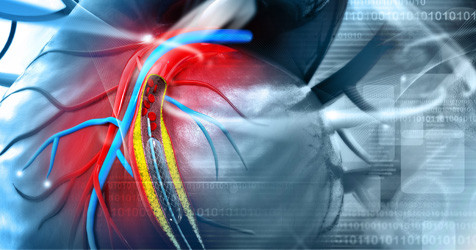
ANGIOPLASTY AND STENT PROCEDURE – A LOOK AT THE PROCEDURE
Friday, October 25, 2019WHAT IS ANGIOPLASTY?
Interventional cardiologists perform angioplasty (also called percutaneous transluminal coronary angioplasty (PTCA), which opens narrowed arteries. They use a long, thin tube called a catheter that has a small balloon on its tip. They inflate the balloon at the blockage site in the artery to flatten or compress the plaque against the artery wall.
WHAT IS A STENT?
A stent is a small, mesh-like device made of metal. When a stent is placed inside of a coronary artery, it acts as a support or scaffold, keeping the vessel open. Stent procedures are usually used along with balloon angioplasty.
WHAT TO EXPECT DURING A BALLOON ANGIOPLASTY OR STENT PROCEDURE?
Patients are usually told not to eat or drink anything after midnight the night before the procedure.
You will most likely have blood tests, an electrocardiogram, and a chest x-ray taken before the procedure.
Once you are ready, small metal disks called electrodes will be placed on your chest. These electrodes hook up to an electrocardiogram machine which monitors your heart rhythm during the procedure.
A needle with a tube connected to it will be put in your arm. This is called an intravenous line or IV.
You will get a mild sedative through the IV to relax you throughout the procedure.
When doctors see the artery into which the catheter will go, a special needle is used to penetrate it.
Doctors usually put the catheter into an artery in your leg, arm, or wrist. Many doctors use the artery in the leg; however, radial artery access (through the wrist) is becoming common practice.
You should not feel pain during this part of the procedure.
Doctors gently thread the catheter through the artery and into your heart. They use a video monitor to see the process. Once the catheter reaches the blocked artery, a harmless dye is injected, and the doctor will take a picture of the coronary arteries. The angiogram helps the doctor see the size and location of the blockage.
Once doctors know the exact location of the blockage, they thread what is called a guidewire through the same artery in the leg and advance it across the blockage. Then, the balloon-tipped catheter is slipped over the guidewire and advanced to the blockage. When this catheter reaches the blockage, the balloon is inflated. As the balloon expands, it presses against the plaque, compressing it against the artery wall. The balloon is then deflated. The catheter, guidewire, and deflated balloon are then removed.
If doctors are placing a stent in the artery, the stent is put at the tip of the catheter, over the balloon. When the catheter is positioned at the blockage, the balloon is inflated, expanding the stent. Once the stent is open, the balloon is deflated. The catheter, guidewire, and deflated balloon are then removed, leaving the stent behind to hold the artery open.
WHAT HAPPENS AFTER THE PROCEDURE?
After you leave the hospital, you should drink plenty of fluids and avoid driving, bathing, and smoking for 1 or 2 days after the procedure. You should also avoid standing or walking for long periods for at least 2 days after the procedure. If you received a stent, you should avoid vigorous exercise for 30 days.
About 35% to 40% of patients who have balloon angioplasty are at risk of more blockages in the treated area. This is called restenosis. Restenosis usually happens within 6 months after balloon angioplasty.
CAN RESTENOSIS BE PREVENTED?
Doctors are always trying to come up with new ways to prevent arteries from re-closing after an angioplasty or stent procedure. In recent years, doctors have used new types of stents. Some of these are coated with medicines that help keep the vessel from re-closing. These coated stents slowly release their medicine into the tissue around the stent, slowing down or stopping restenosis.
WHY KIMS?
KIMS’ expert medical team with advanced technology ensures a quick and skilled response to individuals suffering a heart attack, thus improving patient care and enhancing as well as expediting treatment options. As time is the crucial factor, we have special core emergency team to help heart patients with immediate assistance. We have the cardiovascular department that houses the cardiac catheterization laboratory and the interventional radiology laboratory that helps with any emergency, giving patients instant attention.
